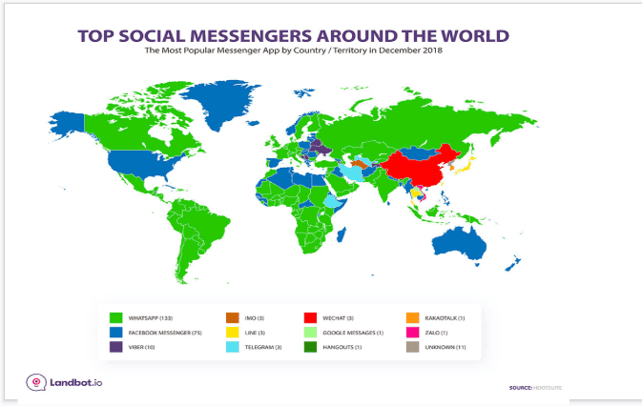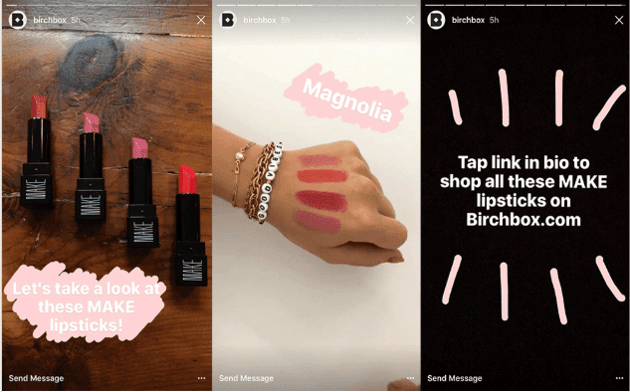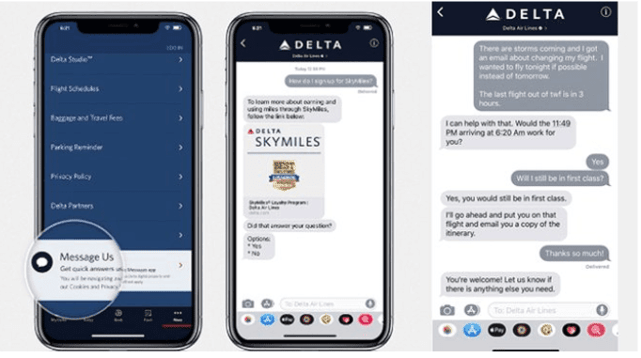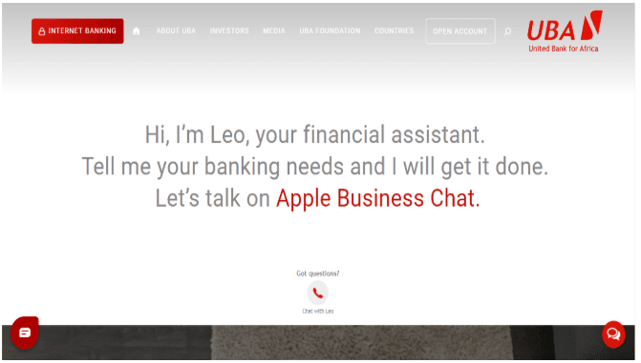
4 Social Messaging Platforms to Explore in 2020
How Brands Can Leverage Social Messaging Platforms to Drive Sales and Loyalty
If you’re like me, you probably have hundreds or thousands (I have 11,147) unread emails in your personal inbox. With the influx of promotions, notifications, and social updates, I’ve been conditioned to ignore most of them. In contrast, I only have a handful of unread messages on Facebook Messenger, Instagram Direct, and WhatsApp.
The Evolution of Social Messaging Platforms
Originally, social messaging apps were created as a tool for chatting with family and friends. Understandably, messages sent on these apps have a high open-rate relative to email, which is typically associated with promotions or work. People are more inclined to read a message from a family member than from a company that is emailing for the fifth time this month trying to convince you to buy a ticket to Aruba.

However, social messaging apps are also gradually becoming tools for people to interact with trusted brands to find or get more information about a brand’s products or services. This blog post explores the rising trend of social messaging apps in conversational marketing. We shine a spotlight on four social platforms that are enhancing their messaging features to help brands better engage their users.
4 Social Messaging Apps Being Revamped for Customer Engagement
One of the biggest challenges that advertisers and marketers will face in the new decade is that a significant part of online activities, including interactions with brands, are moving away from public news feeds and timelines into private chats.
Facebook’s founder and CEO, Mark Zuckerberg attests to this emerging trend in a note he wrote last year. In his words:
...over the last 15 years, Facebook and Instagram have helped people connect with friends, communities, and interests in the digital equivalent of a town square. But people increasingly also want to connect privately in the digital equivalent of the living room. As I think about the future of the internet, I believe a privacy-focused communications platform will become even more important than today's open platforms.”
Interestingly, consumers don’t seem to draw a hard line between chatting with friends and chatting with brands. A 2017 report from Eptica suggests that 60% of consumers want brands to offer chat options and 65% of consumers were happier using chat than in 2012. The only caveat is that consumers they’ll want to consent to the chat rather than being harassed with random messages in their inboxes.
On the contrary, many brands are hesitant to chat with consumers and are still placing a large portion of their focus on one-way communications via ads and other marketing content. Interacting with customers over chat, however, requires two-way communication and is often harder to get right.
There are some first-mover brands that are already changing the rules of the game and leveraging messaging apps to reach customers. Social media platforms, also anticipating a shift in consumer behavior away from news feeds and towards private chats, have added new features that brands can capitalize on. What are some of these changes platforms have introduced and how are brands leveraging them?
1. Instagram speeds up the user journey from Stories to DM
Instagram started out as a social network for sharing pictures and videos, and it later became a place for brands to reach and engage with the customers. Instagram is now a powerful marketing ally for brands, serving as a tool for showcasing pictures and videos about their products. Instagram has a potential advertising reach of about 850 million users and one-third of the most viewed stories are from businesses.
Many brands already do a great job using Instagram to create brand awareness. Likes, comments, and shares also provide a decent amount of customer engagement. Unfortunately, many brands are missing out on the bigger opportunity that Instagram Direct presents. Instagram Direct helps brands to extend the impact of personalized engagement to improve sales and loyalty.
For instance, Instagram Direct messages are now supported on Facebook Page Inbox to enable brands and multiple admins / moderators to manage incoming and outgoing messages in their DMs natively on desktop. For brands that send and receive lots of messages, managing conversations through a single account and via mobile devices can be cumbersome. This change improves direct messaging workflows for brands without the need for third-party apps.
Stories on Instagram have also been revamped to feed into the marketing efforts of brands via direct messages. For instance, people watching a brand’s Instagram Stories can now DM the brand directly from the story, be it to express interest in a promotion or to ask for more product information.

Instagram has also rolled out the Chat Sticker which serves as a call-to-action that brands can use to get users to join a group chat. Brands might find it useful to engage in an exclusive chat for segmented, highly engaged, and loyal audiences to send them exclusive announcements and promotions. These simple updates effectively reduce the user journey from leaving the stories, clicking on the brand profile, and then hitting the DM icon.
However, engaging customers via private chat requires a delicate balance - there’s the risk that unsolicited messages might be considered spammy. Either brands or users can initiate a conversation on Instagram by sending a message to the other party. However, the unspoken convention seems to be that customers initiate the conversation and the brand responds to continue the conversation. However, brands can also start a DM conversation provided that they have obtained the user’s consent to send a direct message.
One way that brands that can manage to get user consent to DMs at scale, is to launch promotional campaigns tied to a DM action. For instance, you can run a #DMyourbrandname campaign in which followers are asked to take a picture with your product or using your service with a promise to send a special message to anybody that gets a certain amount of likes on their post. Such a campaign serves the dual purpose of providing you with user-generated content and curiosity about the “special message”. Additionally, since you have their consent to send them a direct message, you can leverage this channel for future remarketing as well.
2. Facebook enables brands to engage in Groups as a Page and to reply privately on comments
At BrandBastion, we believe in actively replying to customer comments on ads and posts, be they praise, complaints or constructive feedback from fans. However, new changes introduced by Facebook in 2019 allow businesses to not just reply on public posts - but also send a DM to the user who left a comment.
When using this feature, the user will get a message from the brand, along with a link to the original post they commented on, to provide context. Brands can use this to follow up with customers, who might miss the brand’s reply on the post if a post has thousands of comments to scroll through. A private conversation could also be a better environment in which to deal with customer issues such as shipping inquiries, as these require exchanging sensitive customer information.
With this feature, Private replies to posts or comments are allowed within 7 days of the creation date of the user post or comment.
Additionally, in 2019 Facebook has rolled out new ways for Pages to participate in Groups under their Page name. Previously, participation in Groups was only allowed for individuals posting in the Group with their individual names.
In a 2019 announcement, Facebook stated:
Pages already have the ability to create groups to build their own communities, and in the coming weeks, Pages will be able to participate in Facebook Groups and join community discussions in a way that is representative of their business or organization.”
3. WhatsApp for Business gets an API
In 2009, WhatsApp started out as a chatting tool between friends and family and it became a rapid success with a user base of 200 million people by 2013. In 2014, Facebook acquired WhatsApp for $19 billion to make the company’s largest acquisition until date. By October 2019, WhatsApp had 1.6 billion monthly active users and Facebook’s homegrown Messenger had 1.3 billion monthly active users.
WhatsApp’s market size and the geographical spread of its user base, especially in emerging markets makes it valuable to marketers and advertisers. In January 2018, Facebook officially launched WhatsApp for Business, which allows medium and large businesses to engage with customers through the WhatsApp Business API. WhatsApp for Business aims to help brands deepen engagement and to potentially unlock new revenue streams.
The API enables brands to power their communications with customers all over the world by leveraging the services of Facebook Partners. Brands can respond to any message within 24 hours for free after which they’ll be required to pay for messages. This idea ensures that brands respond to users speedily and prevents spammy behavior.
Netflix is one of the first brands experimenting with the personalized feel that WhatsApp communication provides. In India (WhatsApp’s biggest market where it has more than 200 million users), Netflix is exploring ways to use WhatsApp to get users to engage with content. Also, the Mirror reports that Netflix might have started testing the feature in the UK as well. Once users agree to be reached via WhatsApp, Netflix sends them information about new releases, content suggestions, trailers, and information relating to their accounts.

It is still somewhat too early to know how the use of WhatsApp as a medium of engagement will move the needle for Netflix. Yet, the fact that Netflix can push content to users without necessarily waiting for them to open its app or visit the website is likely to have a net positive effect on increasing engagement.
KLM is another leading brand leveraging WhatsApp for Business to unlock deeper levels of engagement from its customers. Fliers typically want real-time hassle-free answers to questions relating to their trips. The video below shows how KLM shares booking confirmation, check-in notifications, flight status, and boarding passes with users via WhatsApp.
4. Apple Business Chat becomes a key part of iOS
In 2017, Apple introduced its Apple Business Chat as a B2C communication platform nestled within iOS 11. Apple Business Chat is powerful in its simplicity - it allows iPhone users to start conversations with businesses found through Safari, Search, Siri, or Maps. Users can buy stuff, schedule appointments, or run through customer service with Business chat.
Apple hasn’t historically been actively involved in the social messaging market. The company creates and sells devices on which apps, including social messaging apps, can thrive. However, in 2019, Apple CEO Tim Cook revealed that the number of its active devices have hit 1.4 billion devices, 900 million of which iPhones. Business Chat is Apple’s way of entering the social messaging market without necessarily being in direct competition with the likes of Messenger and WhatsApp.
Fashion brands, such as Burberry, Men’s Wearhouse, and La Redoute, as well as brands in the travel and hospitality industry, such as Hilton, Four Seasons, Kimpton, and Delta Airlines (as shown in the screenshot below), are also taking the lead in embracing Business Chat.

On the surface, Business Chat doesn’t seem to be much different from Facebook Messenger or other messaging apps. However, the fact that Business Chat isn’t tied to a social network might make it useful for brands targeting demographics that are wary of social media. Interestingly, financial services brands such as Ameritrade, Wells Fargo, American Express, Credit Suisse, and AXA Insurance are some of the first brands piloting the feature.
In fact, Apple Business chat is already incorporated into the customer engagement process of one of Africa’s leading banks as a tool for opening the economy of the region to global stakeholders.

In Summary
Social Messaging apps are becoming much more than just tools to chat with friends - they are also a way for users to discover information about products and services and to chat with brands directly. Social network companies are not ignorant of the fact that there’s value in facilitating B2C conversations in private chats.
In addition, brands must understand the importance of the trust component of social messaging apps. It is essential for brands to:
- get users’ consent to chat,
- set expectations for the kind of user experience customers can expect, and
- ensure communications are as relevant as possible, avoiding sending spammy, promotional messages.
For brands that already have a presence across Facebook, Messenger, and Instagram, there are a few ways you can start driving people to your social messaging channels:
- Setting up Click to Messenger Ads on Facebook. This is a great way to get started in using social messaging to drive personalized engagement. Click-to-Messenger Ads, especially when crafted to redeem an offer can lead people into starting a conversation as part of a larger marketing plan to increase brand loyalty and sales.
- Publishing Instagram Stories that click-to-DM. Beyond using Instagram stories to build awareness and engagement, the Click-to-DM feature now transforms Instagram stories into a tool to funnel people into your conversational marketing pool because users can message a brand directly from stories. Adding a simple “Message Us” CTA into your Instagram stories can help viewers take immediate action that gets a conversation started.
- Designing a “pull” strategy to entice customers to open up a private conversation with your brand. This can be done through offering them a coupon code or an invitation to your loyalty program, for instance.
Would you like to stay on top of your customer engagement with a scalable social media moderation + alerts solution that provides 24/7 AI + human real-time coverage in 43 languages?
Let's start a conversation
